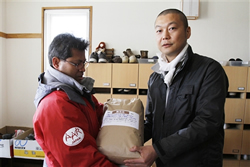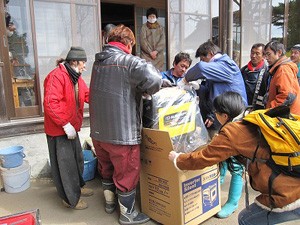 In Iwate Prefecture’s Kamaishi City, the larger evacuation centers have been receiving relief supplies and medical services, but AMDA reports that the management of aid stocks needs to be improved. They also report that communication lines to the town of Otsuchi are still out and some evacuation shelters remain isolated. AMDA’s 14th and 15th teams arrived on the 27th and 28th respectively, bringing their total to 88 personnel. They were joined by overseas teams that had asked to work with them—from Korea (3 doctors, 2 coordinators, and 1 interpreter from Korean Medical Association and Medipeace), Malaysia (2 coordinators from MERCY Malaysia), and AMDA Indonesia (2 doctors and 2 med students).
In Iwate Prefecture’s Kamaishi City, the larger evacuation centers have been receiving relief supplies and medical services, but AMDA reports that the management of aid stocks needs to be improved. They also report that communication lines to the town of Otsuchi are still out and some evacuation shelters remain isolated. AMDA’s 14th and 15th teams arrived on the 27th and 28th respectively, bringing their total to 88 personnel. They were joined by overseas teams that had asked to work with them—from Korea (3 doctors, 2 coordinators, and 1 interpreter from Korean Medical Association and Medipeace), Malaysia (2 coordinators from MERCY Malaysia), and AMDA Indonesia (2 doctors and 2 med students).
 Peace Winds Japan reports that they are carrying out efforts in Kesennuma and Minamisanriku (Miyagi Prefecture) as well as Rikuzentakata and Ofunato (IwatePrefecture). It has been two weeks since the earthquake and tsunami struck, and the fatigue and cold nights are taking their toll on evacuees. In response, on the 28th they began building a temporary bath at a shelter in Ofunato. Peace Winds Japan also is collecting and delivering clothing, underwear, and sanitary items, which are in great demand at the shelters.
Peace Winds Japan reports that they are carrying out efforts in Kesennuma and Minamisanriku (Miyagi Prefecture) as well as Rikuzentakata and Ofunato (IwatePrefecture). It has been two weeks since the earthquake and tsunami struck, and the fatigue and cold nights are taking their toll on evacuees. In response, on the 28th they began building a temporary bath at a shelter in Ofunato. Peace Winds Japan also is collecting and delivering clothing, underwear, and sanitary items, which are in great demand at the shelters.
AAR Japan updated their report on a Miyagi Prefecture senior daycare center, Sasae-ai, that its staff had found had been washed away by the tsunami. The center’s representative had been able to track down many of the seniors—some in shelters, others staying with relatives, etc.—and AAR brought food and other relief supplies for them. On the 28th, they delivered supplies to facilities in Miyagi Prefecture for seniors and those with disabilities in Tome (4 locations), Kurihara (2), and Yamamoto (1).
AAR also reported on a visit last week to Higashi Matsushima (Miyagi Prefecture), where they brought supplies to a nursing home now housing about 100 seniors. None of the staff has gone home since the disaster struck. Among other supplies, AAR brought rice that had been donated from a local organic rice farm. The farm’s clients had asked the farm to send their portion of rice to the disaster survivors, and the farm processed it specially so that as little water as possible would be needed to cook the rice.
NICCO reports that through a matching program with Japan Platform, 64 generators donated by Fuji Heavy Industries arrived in Rikuzentakata, and NICCO will be delivering those to the shelters that need them most. Two challenges, however, are to find gasoline and to provide instructions on using the generators. Not only will the generator allow the shelters to have light, but it will also allow them to pump well water that can be used for bathing.
NICCO is currently working in two districts of Rikuzentakata—Otomo and Hirota—to provide medical treatment and everyday necessities, install toilets, and help restore electricity and water. The peninsula on which they are located is still lacking electricity, water, and other lifelines, and no one can say when they might be restored. There is no trace left of the main rail station on the peninsula, the JR Otomo Station.
